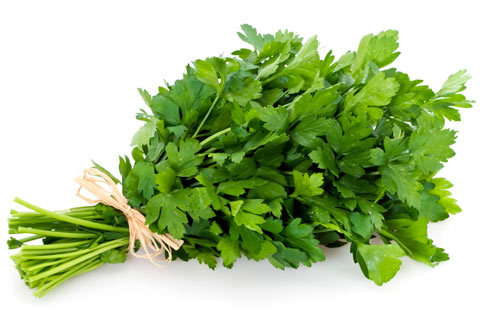Parsley's Anticancer Effects

Fun Facts:
Curly parsley adds ornamental value to your garden — and it also attracts swallowtail butterflies and beneficial insects that feed on pests that will damage your vegetable and herb garden. (i.245)
Parsley garnish not only makes for a pretty plate, it can also be used to freshen your breath. Finish your meal by chewing on the garnish and your fears of garlic breath will vanish! (i.245)
Parsley (Petroselinum), which is in the Apiaceae family of herbs, is native to western Asia and southern Europe. Its name is derived from the Greek word for rock celery — most likely because they are plant relatives (along with carrot). The biennial herb is often cultivated worldwide as a popular annual for culinary purposes. Parsley leaves have a pleasant aroma, and the herb grows to a height of up to 3 feet depending on type. (i.241-243)
There are three main types of parsley in the US, namely: (i.243, 244)
- Curled-leaf (P. crispum), the most common type. Typically growing between 8 and 14" tall, it makes and attractive, densely clumped garden plant and may be used either fresh or dried as garnish or in food products respectively.
- Flat-leaf/Italian (P. neapolitanum) parsley has a more robust taste than P. crispum and is used as flavoring in stews, sauces and soups, and is higher in antioxidants than curly parsley. It grows quite tall but its form is a bit straggly.
- Turnip-rooted/Hamburg (P. tuberosum) is a newer species sporting fern-like leaves. But it's the large, white edible roots that are used for seasoning foods, not the leaf.
Parsley as Medicine
Although most people today use parsley as food because of its attractive aroma and savory flavor, it has been used as an herbal medicine for centuries. Modern scientific studies indicate that the herb has several good healing properties that may be helpful in preventing or treating various serious diseases, including cancer. (i.242)
Parsley contains plenty of iron and folate, as well as vitamin A , vitamin C, and vitamin K. Vitamin C is the main water-soluble antioxidant in the body and has powerful anti-inflammatory properties while vitamin A boosts the immune system. Another important element found in parsley is beta-carotene, an antioxidant phytonutrient the body can convert into vitamin A. Research suggests beta-carotene can reduce the progression and development of colon cancer. The herb is also a good source of fatty acids, fiber, and amino acids important to good health. (i.242)
Cancer-Fighting Phytonutrients in Parsley
The essential volatile oils in parsley include terpenoid and flavonoid compounds (e.g., alpha-thujene, eugenol, and limonene). These and other polyphenols in parsley have good antioxidant and other cancer-fighting properties, including: (i.42, 242)
- Myristicin. A flavonoid, myristicin is one of the major components in parsley leaf oil. It exhibits antioxidant protection against UV radiation and also activates the antioxidant enzyme GST (known to prevent tumors from developing) in the liver and small intestines. Results from animal studies suggest myristicin in parsley can help prevent tumors from forming in the lungs by protecting them from carcinogenic cigarette and grill smoke toxins. (i.242, 246)
- Falcarinol, falcarindiol, and their derivatives. One of over 2000 polyacetylene compounds found in plants, these biologically active phytochemicals are more common in members of the carrot family (such as parsley) than other plants used for food. At very high concentrations polyacetylenes can be toxic, but at low levels they have been shown to have beneficial effects. It has potent anti-inflammatory, antibacterial, and antifungal properties. In fact, in some vegetables high in anthocyanins such as purple carrots, falcarinol was found to be the main anti-inflammatory agent instead. Falcarinol and its derivatives are effective and potent inhibitors of LOX and NF-κB, inflammatory factors implicated in tumor growth and progression. Falcarindiol is effective against COX inflammatory enzymes (especially COX-1), which are involved in cancer. Lab tests show falcarinol is toxic to leukemia, stomach, and melanoma cancer cell lines, but does not harm normal cells in amounts typically found and absorbed from foods. Animal studies indicate it can reduce the number and size of precancerous colon cancer lesions. (i.247)
- Quercetin and luteolin. Two of five flavonoids studied in a prospective population study in almost 900 men, high intake of quercetin and the other polyphenols were associated with lower rates of cancer. Quercetin, a common flavonol-type flavonoid can inhibit an enzyme known to activate pro-carcinogenic substances. Lab studies show that luteolin, a flavone flavonoid, is a powerful anti-inflammatory. Both have also been shown in lab and animal studies to naturally inhibit tumor invasion and subsequent metastasis. Spread of cancer at sites other than where the primary cancer originally occurred, and is the main cause of death from cancer. (i.42, 138, 178, 242, 248-250)
- Apigenin is a particularly powerful anticancer flavone-type flavonoid that parsley is abundant in. Research suggests that its antioxidant and anti-inflammatory properties may offer protection against DNA and cellular damage that promote the development of cancer, and it also inhibits activation of carcinogens by enzymes. In addition, both animal and human studies indicate apigenin may also be natural herbal remedy to help treat a number of different cancers, including leukemia and those located in the following organs: (i.138, 178)
Apigenin's anticancer activities include inhibiting tumor growth, invasion, and metastases. Some studies show it can also induce death of certain types of cancer cells. (i.138, 178)
Selecting and Storing Parsley
Choose fresh, crisp, deep green parsley for the best flavor. However, even though fresh parsley has better flavor, parsley is one herb you may want to use dried as well. Lab analysis shows that dry parsley actually has higher antioxidant potency than fresh. Try using it in dishes such as soups and stews where it is not the predominant flavor, or if fresh parsley is not readily available. When buying dried parsley flakes, look for those labeled as organically grown to avoid irradiation. (i.244)
Use plastic bags to store fresh, unwashed parsley in the refrigerator. To extend storage times you can lay out flat leaf parsley on paper towels to make your own dried version. Once dry store in a tightly sealed container in the refrigerator. Curly parsley is better frozen for long-term storage and added unthawed to recipes. (i.244)
Be sure to swish fresh parsley in a bowl of cold water to remove any dirt or sand before using. Drain the water and repeat until the water is clear. (i.244)
Growing Parsley at Home
It is best to grow parsley in an open area where the plants can receive light for between 6 and 8 hours per day. Plant parsley in rich, well-drained soil with a pH level of between 6 and 7. The easiest method to start the herbs is seed propagation although they germinate slowly. You can start parsley by seed or buy plants at a local garden center to transplant into your home garden. Parsley can also be planted indoors, or in container gardens. (i.243, 250)
If planting seeds you may want to start indoors 6 to 8 weeks before the last frost date because they are slow to germinate (up to 5 weeks). To speed up germination, soak the seeds (which should be relatively fresh) in warm water 24 hours before planting and use biodegradable peat pots so you don't disturb the roots when transplanting. You can also try planting parsley in hydroponic units indoors — experts indicate they germinate easily in the units. (i.243, 245, 251)
Different types of insects attack parsley. Consult the State Cooperative Extension Service to determine the types of pests and the recommended control method. Parsley is usually affected by septoria leaf spot, a foliage disease caused by a fungus known as Septoria apiicola. The best prevention method is buying quality seeds and plants. (i.241)
The preferred harvesting method is by hand — snip sprigs of the fresh leaf as needed. If you want multiple cuttings, the cuttings must be at least one inch above the crown. Start with the outside stalks to encourage new growth. (i.243, 245)
Be Careful of Oxalates in Parsley
Parsley has a relatively high amount of oxalates, a substance that can inhibit calcium absorption and potentially cause health problems — especially in people with untreated kidney and gall bladder conditions (e.g., kidney stones). However, research evidence suggests that limiting oxalate-rich food may not be the best way to avoid this risk, even for those susceptible to kidney stones. "Should People Prone to Kidney Stones Use Turmeric?" is a good source for more information and an overview of recent research regarding dietary oxalate intake. Although falcarinol, a component of parsley, is known to cause allergic skin reactions, these are rare in food sources — possibly because of lower concentrations than in other types of plants or because people become sensitized to the substance from consuming it. (i.242, 247, 252, 253)



